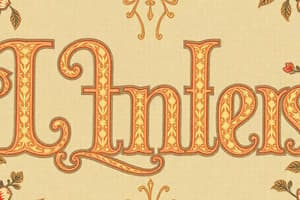Podcast
Questions and Answers
What is the primary purpose of syllable recognition?
What is the primary purpose of syllable recognition?
- To understand the meanings of words
- To improve handwriting skills
- To identify the number of sounds or syllables in a word (correct)
- To learn new vocabulary
Which of the following is NOT mentioned as a strategy for teaching syllable recognition?
Which of the following is NOT mentioned as a strategy for teaching syllable recognition?
- Using syllable markers or syllable division
- Practicing writing words in cursive (correct)
- Using visual and auditory cues
- Teaching syllable types and their sounds
What is the relationship between syllable recognition and reading fluency?
What is the relationship between syllable recognition and reading fluency?
- Syllable recognition has no impact on reading fluency
- Syllable recognition is more important for writing than reading
- Syllable recognition is only important for beginning readers
- Syllable recognition is essential for decoding words and reading fluently (correct)
Which of the following skills is NOT mentioned as essential for developing strong reading and writing skills?
Which of the following skills is NOT mentioned as essential for developing strong reading and writing skills?
What is the importance of understanding the relationships between letters and sounds?
What is the importance of understanding the relationships between letters and sounds?
How many letters are in the English alphabet?
How many letters are in the English alphabet?
What are the uppercase letters of the alphabet called?
What are the uppercase letters of the alphabet called?
Which of the following is NOT a characteristic of lowercase letters?
Which of the following is NOT a characteristic of lowercase letters?
What is the primary focus of phonics instruction?
What is the primary focus of phonics instruction?
Which of the following is NOT a component of phonics instruction?
Which of the following is NOT a component of phonics instruction?
How is phonics instruction typically used?
How is phonics instruction typically used?
Flashcards are hidden until you start studying
Study Notes
Letters of the Alphabet
The English alphabet consists of 26 letters, which can be divided into uppercase and lowercase forms. These letters represent different sounds based on their position within the word and their relationship with other consonants and vowels. They form the basis of reading and writing skills needed for communication and comprehension.
Uppercase Letters
Uppercase letters (or capital letters) stand out more visually and are used for emphasis when needed. There is only one letter of each type among them, such as A, B, C, D, E, F, G, H, I, J, K, L, M, N, O, P, Q, R, S, T, U, V, W, X, Y, and Z.
Lowercase Letters
Lowercase letters (or small letters) are used to form words for most of the time. They are the actual letters of the alphabet: a, b, c, d, e, f, g, h, i, j, k, l, m, n, o, p, q, r, s, t, u, v, w, x, y, and z.
Phonics
Phonics is a way of teaching reading and writing that focuses on the sounds that letters make. It is a systematic, explicit, and comprehensive approach to the teaching of reading and writing, which requires the teacher to build foundational skills in phonemic awareness, phonics, fluency, vocabulary, and comprehension. Phonics is used in different reading programs and is often applied in conjunction with other reading instruction methods.
Phonics is beneficial for both reading and spelling, as it helps learners understand the relationship between letters and sounds. This knowledge is essential for decoding words, reading fluently, and comprehending texts.
Syllable Recognition
Syllable recognition is the ability to identify the number of sounds or syllables in a word. It is a crucial skill in reading and spelling because it helps readers understand the structure of words and the relationships between letters and sounds.
There are several strategies for teaching syllable recognition, such as using syllable markers or syllable division, teaching syllable types and their sounds, and using visual and auditory cues. These strategies can help learners develop their syllable recognition skills, which are essential for reading and spelling.
In conclusion, understanding the alphabet letters, phonics, and syllable recognition is crucial for developing strong reading and writing skills. The ability to recognize letters, sounds, and syllables helps learners decode words, comprehend texts, and communicate effectively.
Studying That Suits You
Use AI to generate personalized quizzes and flashcards to suit your learning preferences.




